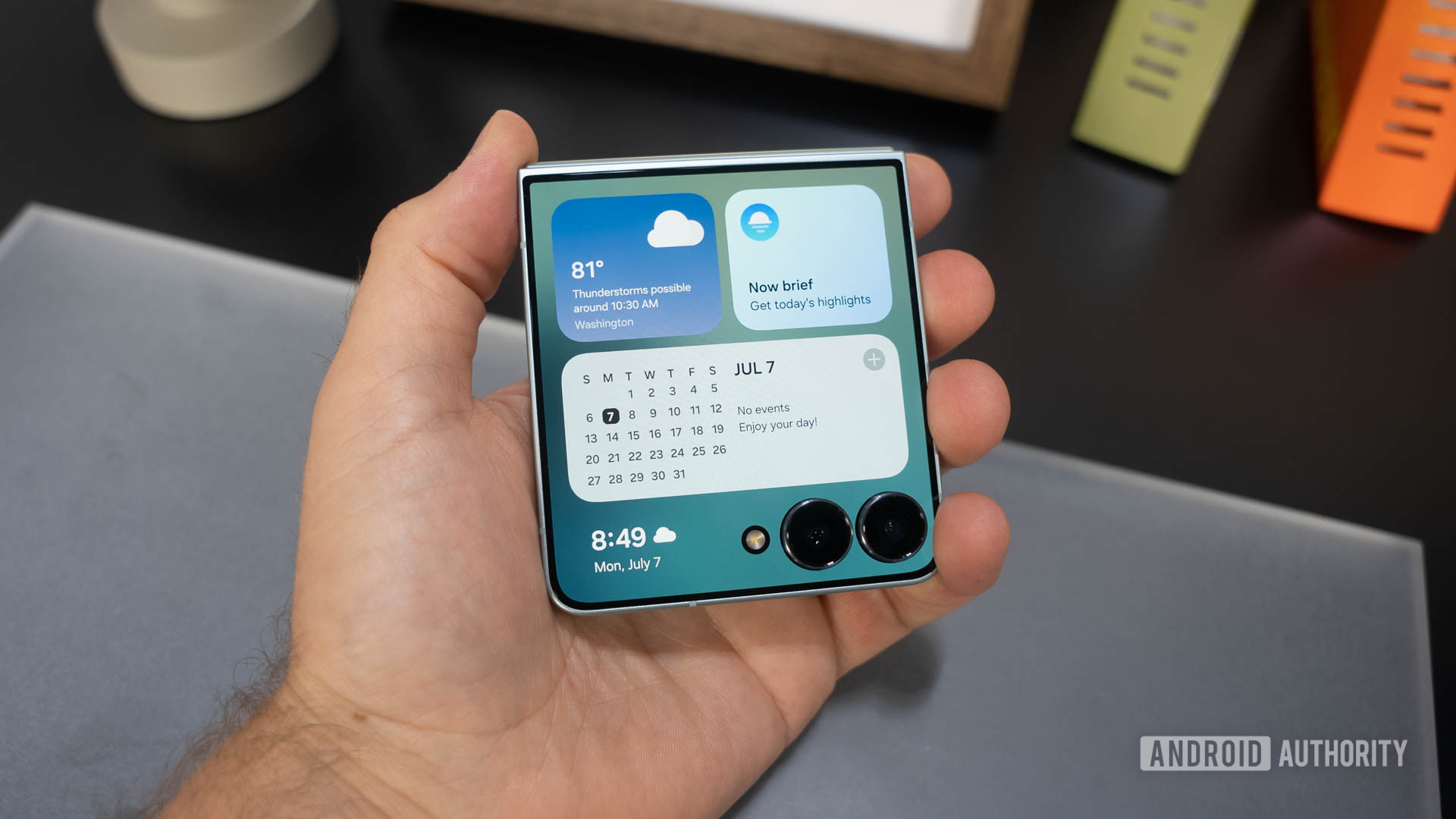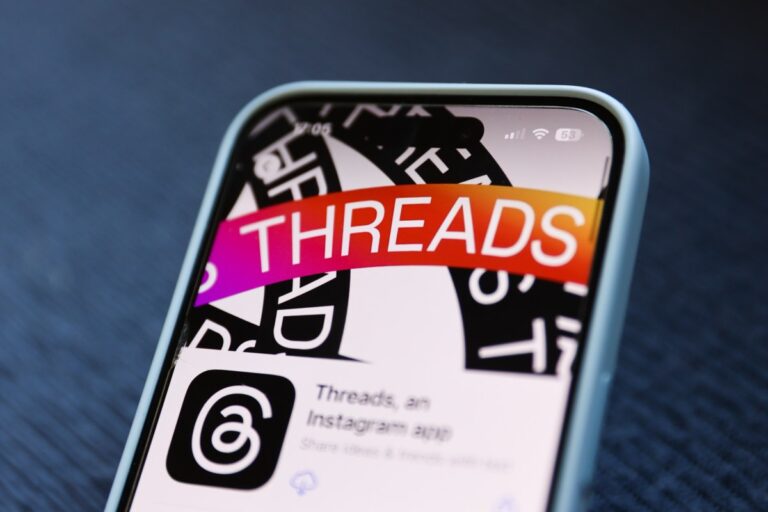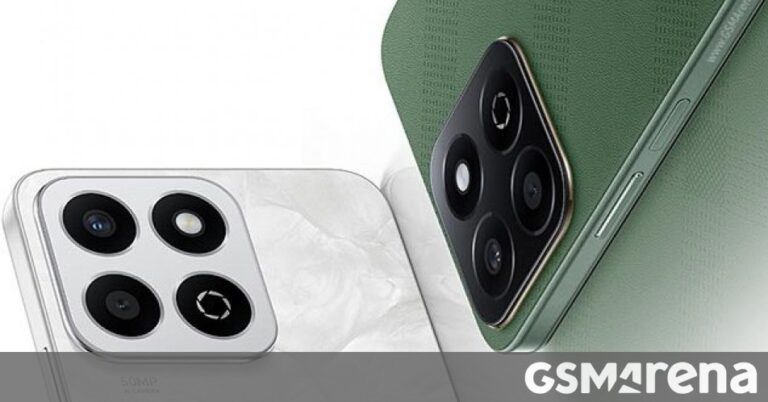Feels great, but the price is way off
When Samsung launches new foldable phones, most people who read sites like Android Authority are only really interested in the Fold model — the ultra-expensive one that opens like a book. However, the foldable that sells the most is the Flip model — the smaller, cheaper design that opens like a clamshell. This year is no different, as the eyes of the internet seem to be exclusively on the Galaxy Z Fold 7, which got its first significant design refresh in years and is positioned to be competitive against Chinese-made foldables, finally.
Don’t let the Fold steal all the thunder, though. The Galaxy Z Flip 7 also launched today, and it similarly received a significant design refresh. It looks better than ever. Once again, this one will likely sell in numbers three times higher than the Galaxy Z Fold 7, so it’s a very important phone for Samsung.
Samsung Galaxy Z Flip 7: Hot or Not?
103 votes
I had the opportunity to use the Galaxy Z Flip 7 for a bit during Samsung’s Galaxy Unpacked event in Brooklyn. While it was immediately obvious that this phone is the best-designed Flip that Samsung has ever made, some of the company’s decisions surrounding it made me uneasy. Is Samsung taking this line in the right direction, or is it veering off the rails?

Samsung Galaxy Z Flip 7
Largest ever Flex Window • 6.9-inch dynamic AMOLED 2X folding screen • 7 years of updates
Melds Galaxy AI with the new edge-to-edge FlexWindow
With a 6.9-inch main display and a 4.1-inch FlexWindow outer display, the Samsung Galaxy Flip 7 focuses on putting AI smarts in your pocket. Measuring just 13.74mm thick when folded, it’s the slimmest Z Flip phone yet. Packed with a 50MP camera and a suite of AI tools, Samsung calls the Z Flip 7 a “pocket-sized selfie studio.”
This feels like peak Galaxy Z Flip design

C. Scott Brown / Android Authority
The cover display on Galaxy Z Flip phones — officially called the Flex Window — has always been a bit weird. Originally, it was just a small rectangle with the most basic of information and usability. Then Samsung made it slightly bigger, but it still felt like an add-on rather than a true display feature. Eventually, Samsung expanded it, making it a strange, folder-shaped display that was certainly more usable, but felt awkward, even on the most recent Galaxy Z Flip 6. While this progression was happening, competitors had jumped ahead and gone all out by making the entire top half of the phone a display (see the Motorola Razr Ultra for a great example of this).
Samsung has finally made the cover display go edge-to-edge, and it looks and feels amazing.
Well, Samsung has finally thrown caution to the wind and copied Motorola. The Galaxy Z Flip 7’s cover display now goes edge-to-edge, with only the two exterior camera lenses obstructing the view. Honestly, I can’t believe it took Samsung so long to do this. Was it waiting to see if Motorola faced pushback or durability complaints? I’m not really sure what the delay was for, but I’m glad we’ve made it to this point.
Not only did Samsung make the cover display edge-to-edge, but it finally got with the times and brought a proper 120Hz refresh rate to it. Every previous Flip had a dismal 60Hz refresh rate, so this is a big step up.
Using the Flex Window felt terrific. Swiping around felt nice and smooth, and the display was bright (it peaks out at 2,600 nits!), colorful, and gorgeous. The significant increase in display size also made things easier to read.
Unfortunately, Samsung is still holding the cover display back from being everything it can be, which I’ll touch on in the next section.
Sticking with design, though, opening up the phone also presents a tangibly better display experience. The inner screen is now larger at 6.9 inches (the Galaxy Z Flip 6 display is 6.7 inches), thanks to noticeably slimmer bezels. Also, the display crease at the hinge is almost invisible. The photo below was the best I could get to show it. For all intents and purposes, it wasn’t there. Granted, after 1,000 folds, it might be more visible, but every model I checked at the Unpacked event looked like this one. How far we’ve come with display creases!

C. Scott Brown / Android Authority
Besides the increase in size, Samsung didn’t have much to tell us about anything new with the inner display. It still is a 1080p LTPO AMOLED screen and still has a 120Hz refresh rate. I’ve never had any complaints about the specs surrounding the inner display, so the fact that it’s larger is more than enough for me.
Once you get past the altered displays, the rest of the phone is pretty much the same as the previous few generations. The sides are totally flat, which we’ve had since the Galaxy Z Flip 6 (or even the Galaxy Z Flip 5, which only had subtle curvature on the edges). The cameras, flash, power button/fingerprint reader, volume keys, and pretty much all other aspects of the phone are just as they were last year.

C. Scott Brown / Android Authority
There are some new colors, though. This year, we have Blue Shadow, Coral Red, and Jet Black as the three colorways that most of the world will see. There’s also a color exclusive to Samsung.com called Mint, which is a light green, as you’d expect. All the colors look great, but the blue is probably my favorite. Samsung always seems to do a great job with providing plenty of fun color options in the Flip series. I wish it took the same approach with its other phone models, but oh well.
New software tricks that feel tangibly useful
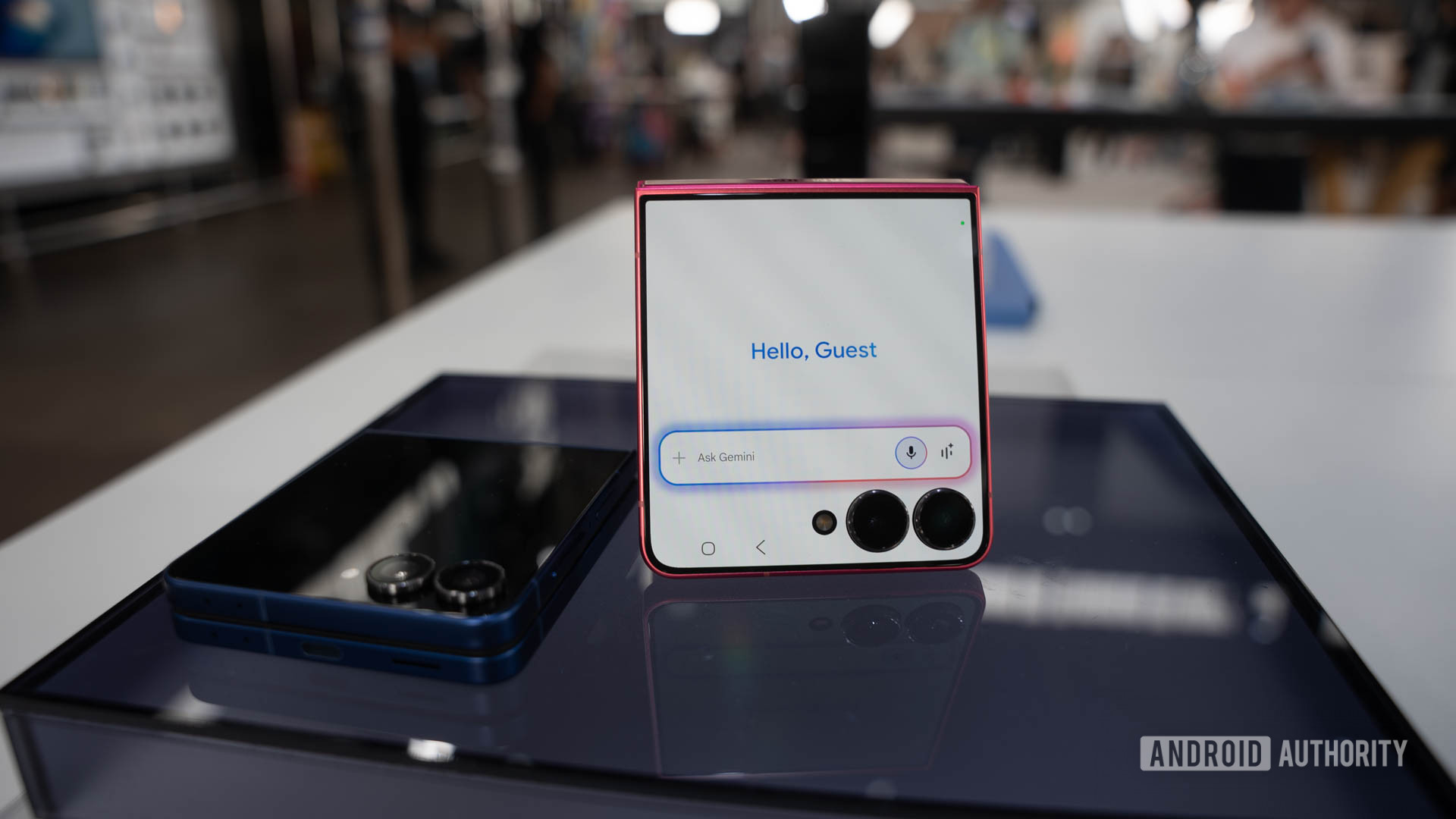
C. Scott Brown / Android Authority
Although making the cover display larger is great and all, Samsung needs to do something with that new real estate. In some ways it has done that, and in other ways not so much.
One of the best new features here is that Gemini works right from the cover display now. You trigger it in the usual way by holding down the power button, but you no longer need to be using the phone in an unfolded state for it to work. Once triggered, you can type out a question or just speak your query out loud. Gemini Live is also supported, so you can have a full-on conversation with Gemini without ever needing to unfold your phone.
Gemini support on the cover display is a big deal, as accessing the digital assistant will no longer require a needless unfolding of the phone.
On top of this, you can also share your camera feed with Gemini from the cover display. This would allow you to, for example, show Gemini what you’re wearing and get a critique on the outfit. You could also show Gemini something in your hand and ask about it. The sky’s the limit here. The only caveat is that the camera is always facing you, so if you want to chat with Gemini about what’s going on in front of you, you’ll either need to awkwardly turn the phone around or just unfold it and use Gemini on the main display.

Hadlee Simons / Android Authority
Now Brief is also available on the cover display now. This useful little widget that debuted on the lock screens of the Galaxy S25 series will give you information about what’s going on when you need it. Flight information will show when you’re about to head to the airport, sports scores will be updated when your favorite team is playing, and weather reports will appear periodically to let you know if you need a raincoat or sunscreen.
Samsung has also promised that it is working with more partners to make Now Brief even more useful. It didn’t have much else to tell us on this front, but it’s clear Now Brief is successful and will only get better over time, so it appearing right on the Galaxy Z Flip 7 cover display is great news.
Now Brief is available on the cover display and you can also easily use zoom features when taking selfies from the Flex Window.
There’s one other cool cover display update, and it involves taking selfies. When you fire up the camera while the phone is folded, your viewfinder will now allow you to digitally zoom in or out on yourself using a convenient slider that appears on the left side of the screen. Additionally, One UI will automatically zoom in or out based on what it sees in the viewfinder, which could be helpful (or annoying — I didn’t have enough time with it to come to a conclusion there, but it did work as expected).

C. Scott Brown / Android Authority
While these are all terrific updates for the cover display, there’s one thing that Samsung still isn’t offering: full app support. As with all other Flip models, if you want to launch any app on the cover display, you’ll still need to use Good Lock to do it. While it’s nice that there’s a workaround to get it working, it is high time Samsung stopped keeping this tucked away there. The introduction of an edge-to-edge cover display was the perfect time to allow full app support, but Samsung let that opportunity pass by.

C. Scott Brown / Android Authority
Outside of cover display updates, though, there is one other major new software tweak for the Galaxy Z Flip 7, and that is full DeX support. Finally! Samsung leaving DeX support off the Flip series has been so bizarre, considering there has been nothing preventing it from offering it (hardware-wise, I mean). This omission has been rectified at last, as not only is DeX support here for the Galaxy Z Flip 7, but it’s also activated by default. Nice move, Sammy.
Finally, Samsung is offering the expected seven years of support for the Galaxy Z Flip 7. That means seven Android upgrades and seven years of security patches. Considering this phone comes with Android 16 out of the box (one of the first globally available smartphones to do so), you’ll be good all the way until Android 23.
The Exynos elephant in the room

C. Scott Brown / Android Authority
OK, so I’ve gotten through all of the cool things going on with the Galaxy Z Flip 7. Now, we need to have a frank discussion about the elephant in the room, which is that under the hood in every area of the world, the Galaxy Z Flip 7 will have the Exynos 2500 processor. Yes, even here in the United States.
Thankfully, this fate did not befall the Galaxy Z Fold 7 — that phone has the expected Qualcomm Snapdragon 8 Elite. Traditionally, though, the two phones have had the same chipset, making all Galaxy Z phones and all non-FE devices in the Galaxy S series part of the overall flagship family. This year, though, Samsung is letting that tradition fade and knocking the Flip model down a peg.
The Exynos 2500 will power the Galaxy Z Flip 7. And that’s everywhere, including here in the US.
To be clear, the Exynos 2500 is almost certainly a good chipset. It’s built on a 3nm process, just like the Snapdragon 8 Elite. It has a strong core setup, a great modem, and powerful NPU capabilities. On paper, it will be more than enough power for pretty much every Galaxy Z Flip 7 customer.
But I can confidently say it will be no match for the Snapdragon 8 Elite. Although we have no benchmarks or other data to show for it yet, based on what we know so far (and over a decade of history to examine), the 8 Elite will trounce the Exynos 2500 by almost every metric. This is a disappointing development for the Flip series. We’ll certainly do the tests to confirm this, though, when we have our own review units.

C. Scott Brown / Android Authority
Another elephant in the room is the camera hardware. You’ll notice I haven’t said anything about that yet. Well, that’s because there have been no significant upgrades in that department. The main sensor is still a 50MP deal, the ultrawide stays at 12MP, and the selfie camera in the display cutout of the inner screen is still 10MP. There is still no telephoto lens, as usual.
Samsung also neglected to bring any tangible hardware upgrades to the cameras this year.
Thankfully, Samsung did bring us one hardware upgrade: the battery. It’s about 7% larger in the Galaxy Z Flip 7 versus the Galaxy Z Flip 6 (4,300mAh vs 4,000mAh). Any battery capacity increase is welcome, obviously, but it’s unclear how much battery life will actually be extended once you factor in the larger cover display and its higher refresh rate. We’ll find out when we do our usual review testing.
So really, what we have here is a phone with a fresh new design, a slightly larger battery, and some very welcome new software features. But, in exchange, we have a processor that does not befit a flagship offering from Samsung and no tangible camera upgrades.
Samsung Galaxy Z Flip 7 impressions: Why is this so expensive?
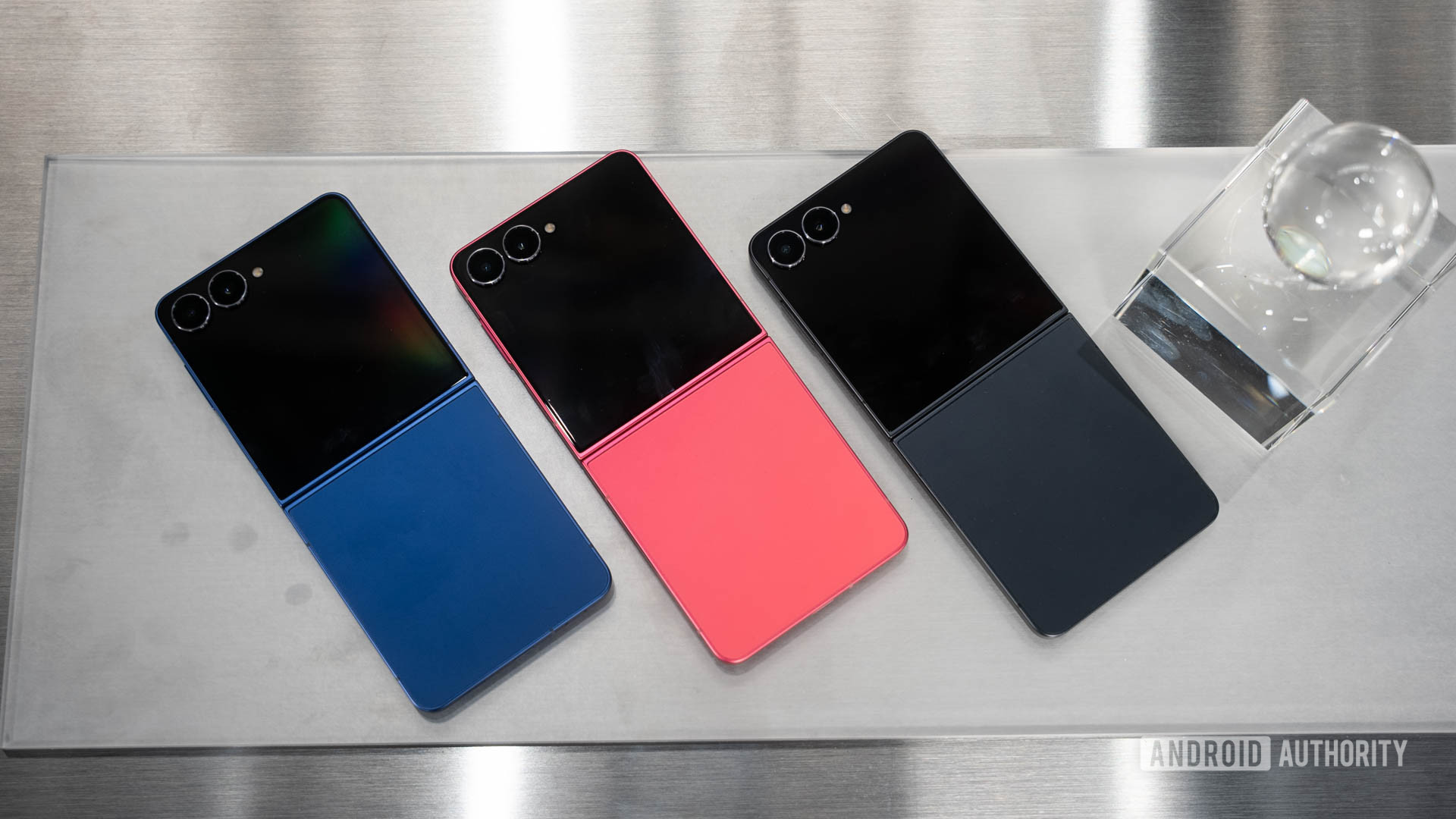
C. Scott Brown / Android Authority
Let me give you a little pricing history for the Galaxy Z Flip series. The very first Flip model cost $1,380. The quick follow-up — the Galaxy Z Flip 5G — cost a whopping $1,449. Shortly thereafter, Samsung dropped the 5G model’s price to $1,199. With the launch of the Galaxy Z Flip 3, though, Samsung brought it down to $999, and there it stayed until last year with a $100 increase for the Galaxy Z Flip 6.
Today, Samsung is launching the Galaxy Z Flip 7 at that same $1,099 price. That’s for the model with 256GB of non-expandable storage.
Samsung is keeping the price of the Galaxy Z Flip 7 at $1,099, despite downgrading the processor and offering few hardware upgrades.
This pricing is very confusing to me. With the money Samsung is saving by using the Exynos 2500 chipset, combined with foldable technology becoming cheaper as the years have passed, shouldn’t that mean this phone would be less expensive, not more?
Perhaps the pricing is due to US tariffs and other geopolitical developments. Perhaps materials have increased in cost and Samsung had no choice but to keep the pricing stable. Whatever it might be, during Galaxy Unpacked, Samsung didn’t make a strong enough argument for why this model didn’t drop in price.
Regardless, this pricing becomes all the more worrisome when you look at the competition. Motorola is the biggest threat to Samsung in this department, and its pricing strategy puts Samsung’s to shame. The entry-tier 2025 Motorola Razr ($699.99 at Amazon) starts at $400 less (!!) than the Galaxy Z Flip 7. This year’s upgraded Motorola Razr Plus ($999.99 at Amazon) has the same $999 price tag as older Galaxy Z Flip phones. And, if you want to go all out, the brand new Motorola Razr Ultra ($1299.99 at Amazon) is more expensive, but comes with the Snapdragon 8 Elite, a 1TB option, a larger battery, a larger internal display with a higher resolution, more RAM, and so much more than I’m going to bother listing here.
Simply put, Samsung’s latest Flip offering is asking too much for too little. Apparently, the company thinks that offering the Galaxy Z Flip 7 FE ($899.99 at Amazon) — which also launched today — will be a nice consolation for cash-strapped buyers. But that phone feels even more awkward than this, as it’s basically the same as the year-old Galaxy Z Flip 6 ($1099.99 at Samsung), which can be found for deep discounts on account of its age. So why bother with the FE?
As I mentioned earlier, Samsung has dropped pricing for Flip phones in the past, so maybe it will see that asking $1,099 for this is probably not going to fly with fans. But, until then, the Galaxy Z Flip 7 feels like a design win that a lot of people won’t get to enjoy simply because it’s not priced competitively.
What do you think? Let me know in the comments below, and be sure to answer our poll at the beginning of this article!
